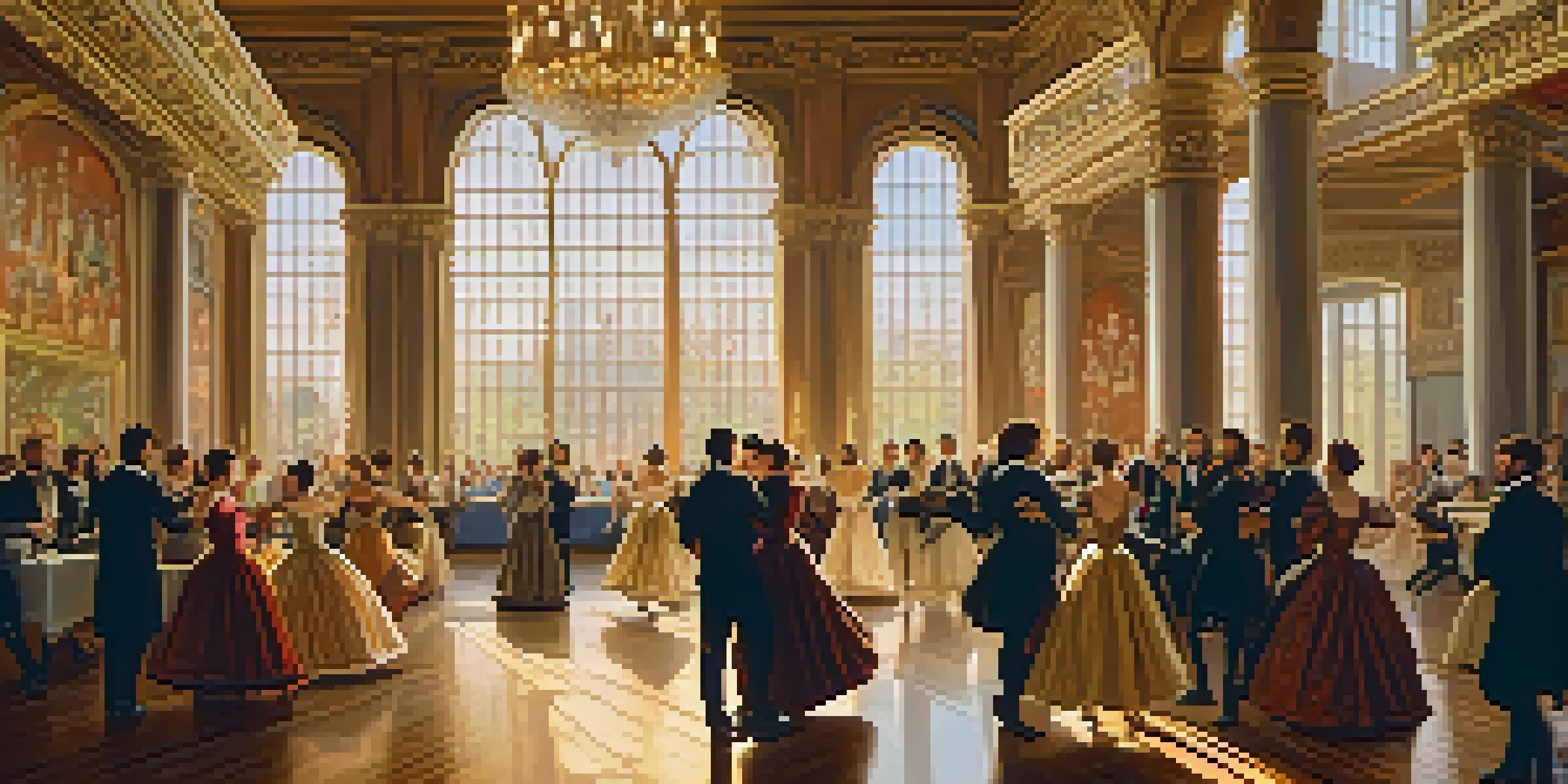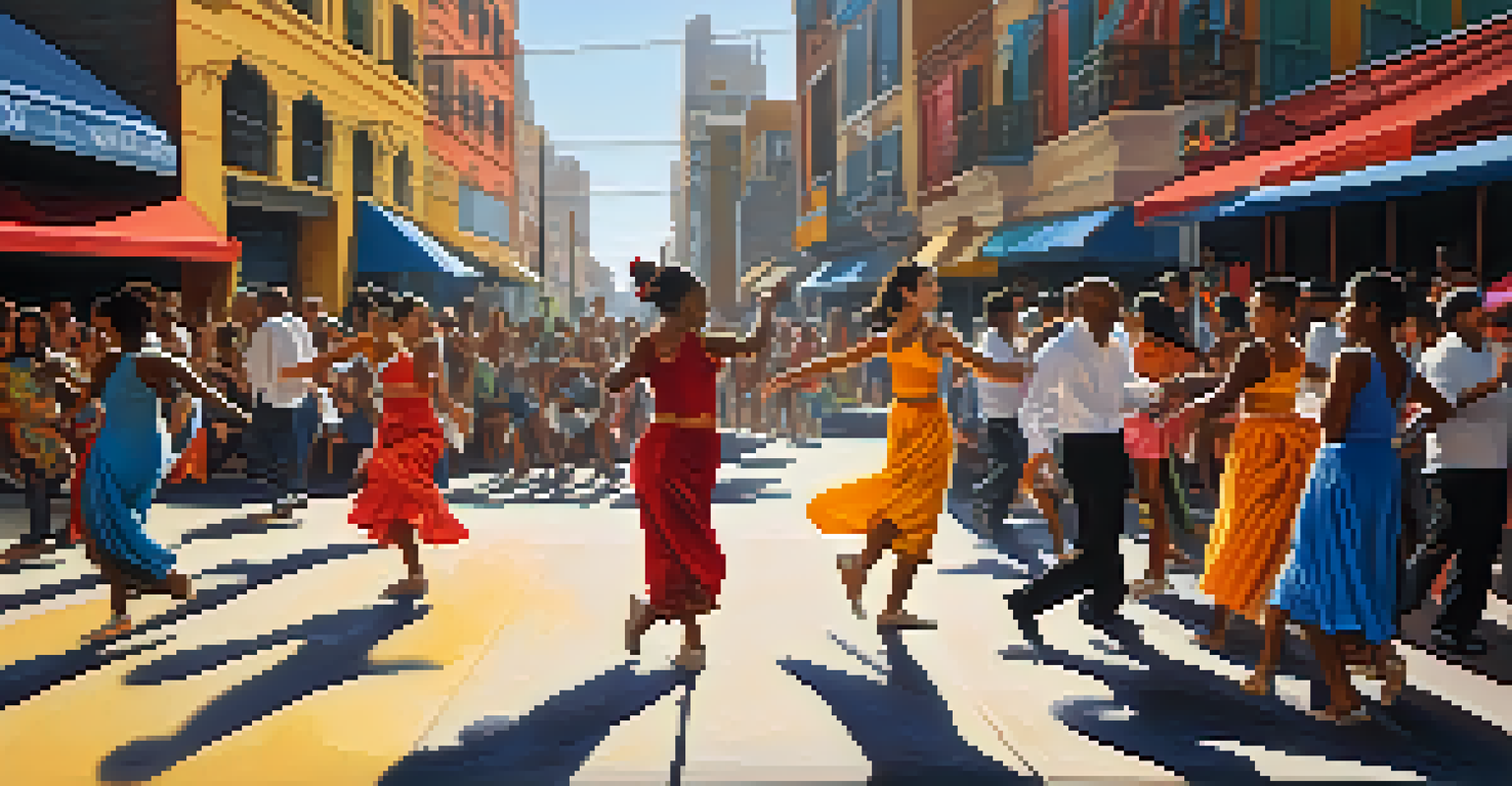Historical Perspectives: The Evolution of Dance and Music

The Origins of Dance and Music in Ancient Cultures
Dance and music have been intrinsic to human culture since ancient times. Early civilizations used these art forms as a means of expression, storytelling, and community bonding. For example, ancient Egyptians celebrated life and death through elaborate dance rituals accompanied by music played on simple instruments like harps and flutes.
Dance is the hidden language of the soul.
These early performances often had spiritual significance, serving as a bridge between the physical and the divine. In many cultures, music and dance were believed to appease gods or ensure a good harvest. This deep-rooted connection highlights how vital these practices were to the identities of ancient peoples.
As societies evolved, so did their musical and dance styles, reflecting the changing values and experiences of the people. This evolution laid the groundwork for the diverse forms of dance and music we enjoy today, intertwining cultural narratives with rhythm and movement.
The Role of Dance and Music in the Middle Ages
During the Middle Ages, dance and music took on new forms, influenced by religious and social changes. Courtly dances became popular among nobility, often characterized by structured movements and a focus on grace. Meanwhile, folk music and dance flourished among the common people, serving as a means of celebration and communal joy.

This period also saw the rise of Gregorian chants in religious settings, emphasizing the importance of music in worship. These chants were often monophonic, meaning they consisted of a single melodic line, creating a sense of unity and solemnity in worship.
Dance and Music as Cultural Foundations
Throughout history, dance and music have served as vital forms of expression and community bonding in ancient cultures.
The interaction between sacred and secular music during this time paved the way for future musical developments. It reflected a society grappling with both its spiritual beliefs and the pleasures of earthly life, illustrating how music and dance can mirror the complexities of human experience.
Renaissance: A Flourishing of Art, Dance, and Music
The Renaissance marked a significant turning point in the evolution of dance and music, characterized by a rebirth of interest in the arts and humanism. This era saw the emergence of more complex musical compositions and the birth of ballet in Italy, which combined dance with theatrical storytelling. The blending of these elements created a rich tapestry of performance art that captivated audiences.
Music can change the world because it can change people.
Composers like Josquin des Prez and Palestrina pushed musical boundaries, introducing polyphony, where multiple independent melodies are sung simultaneously. This innovation added depth and complexity to music, making it more expressive and engaging.
Dance during the Renaissance was not just a form of entertainment; it was a social necessity. Noble courts would host elaborate balls, where dance was a crucial part of social interaction, reflecting both status and cultural sophistication. This intertwining of music and dance set the stage for future artistic collaborations.
Baroque Period: Theatricality in Music and Dance
The Baroque period brought a dramatic flair to both music and dance. Characterized by ornate detail and emotional intensity, this era saw the rise of opera, which seamlessly combined vocal performance, orchestral music, and dance. This multifaceted approach created a new form of storytelling that captivated audiences across Europe.
Composers like Johann Sebastian Bach and George Frideric Handel explored intricate musical structures, emphasizing contrast and ornamentation. Their works often included dance forms like the sarabande and gigue, showcasing the close relationship between dance and music during this time.
Evolution Reflects Social Changes
As societies evolved, so did their musical and dance styles, mirroring changing values and experiences.
Additionally, dance styles became more codified, leading to the development of ballet as a formal art. The establishment of dance academies, particularly in France, set standards for technique and choreography, influencing how dance would be performed and perceived in the centuries to follow.
The Classical Era: Structure and Elegance in Performance
The Classical Era brought about a refined approach to music and dance, focusing on clarity, balance, and structure. Composers like Mozart and Haydn emphasized form and orchestration, creating symphonies and chamber music that highlighted the interplay between instruments. This era's music was often lighter and more playful, mirroring the elegance of the time.
In dance, the emergence of ballet as a distinct art form flourished. The establishment of the Paris Opera Ballet and the introduction of renowned choreographers like Jean-Georges Noverre elevated ballet to new heights, emphasizing storytelling and character through movement.
The intertwining of choreography and musical composition during this period exemplified the collaborative spirit of the arts. Musicians and dancers worked closely together, each enhancing the other's performance, setting a precedent for future artistic endeavors.
Romanticism: Emotion and Individualism in Dance and Music
The Romantic period marked a shift towards emotional expression in both music and dance. Composers like Chopin and Tchaikovsky infused their works with passion and drama, evoking deep feelings in listeners. This era celebrated individualism, allowing artists to explore personal narratives and cultural themes through their art.
In the realm of dance, this emotional intensity was mirrored in the rise of ballet's dramatic storytelling, often incorporating themes of love, loss, and the supernatural. The works of choreographers like Marius Petipa and the emergence of iconic ballets such as 'Swan Lake' showcased the expressive potential of dance.
Digital Age: Global Artistic Fusion
In the digital age, dance and music have become more accessible, leading to innovative fusions of styles and global collaboration.
This period also saw increased accessibility to dance and music, as public performances became more common. The blending of artistic expression and emotional storytelling resonated with audiences, solidifying the importance of both dance and music in conveying the human experience.
The 20th Century: Innovation and Diversity in Dance and Music
The 20th century heralded an explosion of innovation in both dance and music, marked by diverse styles and genres. From jazz and blues to rock and roll, musicians began to experiment with new sounds and rhythms, reflecting the cultural shifts of the time. This era also saw the rise of popular music, with artists like Elvis Presley and the Beatles reshaping the music landscape.
Dance experienced a similar transformation, with the emergence of various styles such as modern dance, hip-hop, and contemporary forms. Choreographers like Martha Graham and Alvin Ailey broke away from classical ballet, embracing improvisation and personal expression, which revitalized the dance scene.

This era's emphasis on diversity and experimentation paved the way for cross-cultural collaborations, blending different musical and dance traditions. The 20th century left a lasting impact on the evolution of these art forms, highlighting their ability to adapt and reflect the changing world.
The Digital Age: Dance and Music in a Globalized World
Now, in the digital age, dance and music have transcended geographical boundaries, becoming more accessible than ever. Platforms like YouTube and social media allow artists to share their work globally, fostering a sense of community among creators and audiences. This interconnectedness has led to the fusion of styles and genres, resulting in exciting new art forms.
The rise of electronic music and digital dance styles exemplifies how technology has influenced artistic expression. Genres like EDM and viral dance challenges on platforms like TikTok showcase the evolving relationship between music and movement, appealing to a younger audience eager for innovation.
As we navigate this rapidly changing landscape, it's clear that the evolution of dance and music is far from over. These art forms continue to adapt and thrive, reflecting the complexities of our global society while celebrating the universal human experience of expression and connection.